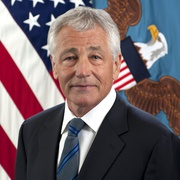
Defense Secretary Chuck Hagel speaks to Marines with II Marine Expeditionary Force and Special Purpose Marine Air Ground Task Force for Crisis Response at Camp Lejeune, N.C., on Tuesday.. U.S. Marine Corps Photo by Cpl. Desire M. Mora
A New Era for the Defense Department
As our military adapts to new threats, so must the defense enterprise from top to bottom, writes Defense Secretary Chuck Hagel.
Today, the Defense Department is undergoing a defining time of transition. After 13 years of war fought by an all-volunteer force, we are reshaping our defense enterprise to adapt for a fiscal environment plagued by perpetual uncertainty and shrinking resources, and to contend with an historic realignment of interests and influences around the world.
Right now our military is addressing today’s crises and security challenges around the world – from degrading ISIL to helping stop the spread of Ebola to reinforcing our NATO allies. And we must be prepared to address a broad range of similarly unpredictable contingencies for years to come.
But America’s long-term security will depend on whether we can address today’s crises while also planning and preparing for tomorrow’s threats. It will depend on whether we meet our nation’s challenges with disciplined choices and strategic vision.
That is what the Defense Department is doing today. Rather than allowing change to be imposed upon us, we are seizing the initiative. We are leading that change, and making long-term, strategic investments in our future—especially in innovation and institutional reform.
For decades, America’s leadership in the world has been anchored not only by our global military presence, but also by our military’s unrivaled technological and operational superiority—an edge that has enabled our nation to project power rapidly across the globe.
But America’s military superiority has never been guaranteed, and it confronts significant challenges on the horizon. Technologies and weapons that were once the exclusive province of advanced nations have become available to a broad swath of militaries and non-state actors. Countries like Russia and China have been heavily investing in military modernization programs tailored to blunt our military’s technological and operational edge.
DOD must therefore accelerate the modernization of our military’s capabilities by making strategic, long-term investments in innovation.
There is precedent for this effort in President Eisenhower’s ‘New Look’ in the 1950s, and DOD’s Long-Range Research and Development Planning Program in the 1970s. Both efforts offset Soviet advantages by sharpening our military’s technology, strategy and plans.
By changing the way we adapt, operate and do business, we can have the same long-term impact these previous strategies did. As I announced last week at the Reagan National Defense Forum, DOD’s new Defense Innovation Initiative will identify and invest in innovative ways to sustain and advance America’s military dominance for the 21st century.
(Related: Realizing the Asia-Pacific Rebalance)
Bringing together senior leadership across the enterprise, this initiative will put new resources behind innovation, but also account for today’s fiscal realities by focusing on our nation’s strategic advantages. Through a new Long-Range Research and Development Planning Program, we will invite some of the brightest minds from inside and outside government to start with a clean sheet of paper and assess what technologies and systems DOD ought to develop over the next 3 to 5 years – and beyond.
We will explore and develop new operational concepts, and new approaches to warfighting, war-gaming and professional military education. We will invest in our most important asset—our people—by re-thinking how we develop managers and leaders. And we will address a new challenge: the fact that DOD no longer holds exclusive access to some of the most cutting-edge technology the way we once did.
Going forward, I expect the Defense Innovation Initiative to significantly shape DOD priorities. As the initiative develops over time, so will its impact on DOD’s budget, plans and programs.
Successfully investing in these long-term priorities requires reform to our defense enterprise, and to DOD as an institution. Our military’s foundation must be reliable, agile, accountable and worthy of all our men and women who serve in it. So with everything we do, from special operations and airstrikes to health care for troops and their families, we must revitalize, renew, and when necessary, reform.
Last week, I announced actions the Defense Department is taking to revamp our nuclear enterprise, including significant new resources and changes in organization, policy, and culture. I will personally hold the department’s leaders accountable to ensure that promises translate into action, and that action translates into real and sustainable improvements to ensure our nuclear deterrent remains safe, secure and effective.
To further concentrate DOD’s focus on critical frontline operations, we are undertaking full reviews of our business and management systems, starting with my own office, the Office of the Secretary of Defense. The Defense Department must embrace business practices that are core to any modern enterprise, private or public.
We are also streamlining the way the Pentagon does business, working with Congress on acquisition improvement and reform efforts. And we are advancing toward greater financial accountability: Over 90 percent of the Defense Department will have its fiscal year 2015 budget statements under audit, and I am committed to ensuring that DOD stays on course to be fully audit-ready by 2017.
The Defense Department is pursuing other reform initiatives that are critical to the long-term health and readiness of the force. We are making important improvements to our military health care system, military justice system and accounting for our military’s missing personnel. We are doubling down to eliminate the scourge of sexual assault, renewing our focus on military ethics and professionalism, synching records and systems with the Department of Veterans Affairs, and integrating women into combat arms—a priority I discussed yesterday with Marines at Camp Lejeune in North Carolina.
In a report issued almost 40 years ago by DOD’s first Long-Range Research and Development Planning Program, a panel of leading defense thinkers considered whether, even with concerted investments, the U.S. military could outpace our determined Soviet adversaries. They concluded we could, but only if two critical assumptions did not change: first, America’s “superior competitive and creative capability,” and second, DOD’s necessary partnership with Congress.
I am confident about our nation’s competitiveness and creativity. While we live in a more dynamic technological environment than we did four decades ago, the ingenuity of our nation’s entrepreneurs, engineers, strategists and scientists remains unrivaled. But we need stronger support from Congress, more today than ever before.
We need long-term budgets, not continuing resolutions. We need the flexibility to undertake critical cost-savings measures, from reducing excess basing to reforming military compensation to shedding outdated platforms and systems. We also urgently need Congress to end the threat of sequestration, which would devastate our military readiness, threaten long-term investments in modernization and undermine our ability to execute our nation’s defense strategy.
As a nation, we have made tough choices before. We must make them again today. That is the only way to sustain our nation’s military edge and the global leadership that depends on it.




